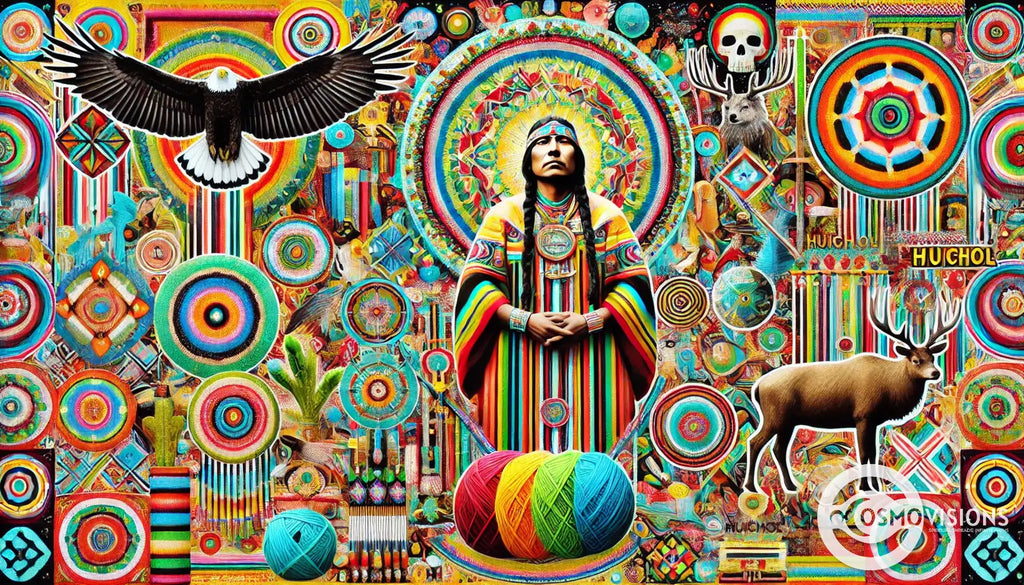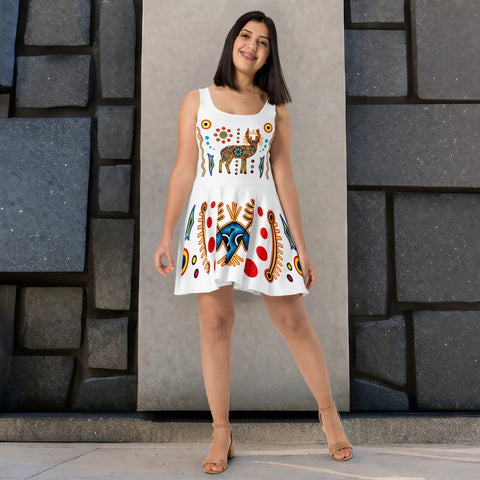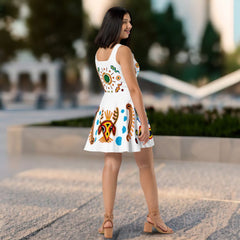Discover the Vibrant World of Huichol Art - A Celebration of Mexican Bead Art

Are you searching for something unique to decorate your home or office? Many people love adding special touches to their spaces but struggle to find original pieces that tell a story.
Huichol art from Mexico is a hidden gem in the decor world, famed for its vivid colors and intricate designs.
Huichol art deeply expresses the Huichol people's culture, history, and spirituality. This beautiful art is meticulously created with tiny glass beads, blending beadwork with yarn painting. The result is stunning visuals that capture tales of nature, deities, and everyday life.
Our article aims to guide you through the enchanting universe of authentic Huichol artwork. You will learn about its significance, the techniques behind these masterpieces, where to find them, and how they can transform your space with warmth and color.
Discover beauty beyond the ordinary…
Discover the Vibrant World of Huichol Art: From Bead to Yarn Masterpieces
Huichol art brings the spiritual world to life through bead and yarn masterpieces. Crafted by the indigenous Huichol people of Jalisco, Mexico, each piece tells a story from their mythology.
The artists create these vibrant works using chaquira beads and colored yarn, mixed with beeswax and pine resin. Animal figures like jaguars, deer, and elephants are adorned in intricate patterns.
Huichol bead art is a sacred and spiritual form of artwork that requires great inspiration, patience, and concentration. It reflects the Huichol Indian approach to life.
The symbols in Huichol's artwork carry rich meanings. Peyote represents enlightenment, while jaguars symbolize power. Owls and flowers add beauty but also hold mystical significance. Buying authentic pieces directly supports the Huichol artisans.
What is Huichol Art and Why is it Significant?
Huichol art shows the world through bright beads and yarn. Huichol crafts include intricate bead and string folk art such as yarn paintings, figures lined with beads, ceremonial bowls, masks, wooden masks, and woven personal adornments. This art shares the stories and traditions of the Huichol people, keeping their culture alive.
Understanding the Cultural Significance of Huichol Art
Huichol art paints a vibrant picture of a culture deeply rooted in spirituality and nature. This indigenous craft, made with colored yarn and seed beads, captures the essence of the Huichol people who live in the Sierra Madre mountains.
Their creations are more than just decoration; they are a language that speaks of their reverence for the natural world and the spiritual journey. Whether it is yarn painting or beadwork, each piece tells a story from their rich heritage and beliefs in deities such as the deer god.
Artisans use chaquira beads and resin to bring to life **symbols like peyote, jaguar, owl, and flower—each carrying deep meanings within Huichol religion. The process involves pressing these materials into beeswax spread over wooden boards—**an ancient method preserved through generations.
With an estimated population of 50,000, this community continues to share its profound messages through art forms admired globally. Through every bead laid and every thread spun, we witness centuries-old traditions coming alive, reflecting the Huichol Indian outlook on life and spirituality.
The Role of Art in Huichol Culture and Beliefs
Art in Huichol culture serves as a deep expression of spiritual beliefs and traditions. Huichol bead art requires inspiration, patience, and concentration, as the Huicholes create vibrant yarn art and intricate beadwork that carry significant meaning.
These pieces often feature motifs like deer, corn, and peyote which are sacred in their religion. Each work tells a story or conveys messages from the spiritual realm based on visions seen during peyote ceremonies.
Making these artworks is more than just a craft; it’s a way to connect with and honor the natural world, ancestors, and deities. Artists use colorful beads and threads to bring their visions to life, embedding each creation with prayers for health, prosperity, and protection.
This blend of artistry and spirituality makes every piece unique—a treasure filled with cultural heritage and mystical symbols.
From Yarn Paintings to Beadwork: The Diversity of Huichol Handcraft
Art reflects the deep spiritual beliefs and rich history of the Huichol people. They express their connection to nature and ancestors through two unique forms: Huichol yarn paintings and beadwork.
Huichol yarn paintings are intricate artworks made by pressing colorful yarn into wax-coated plywood disks. Each painting tells a story from the tribe's mythology and is considered one-of-a-kind. This method allows them to share stories filled with symbols important to their culture.
Beadwork takes another form, covering sculptures in dazzling patterns made from tiny glass beads. These pieces range from masks to animal figures, each covered in intricate designs that speak of nature, gods, and myths.
The technique involves placing thousands of beads onto surfaces prepared with wax or resin, forming images that carry deep meanings within Huichol traditions. Together, these crafts showcase the diversity and richness of Huichol handcrafts, offering a window into a world where art serves as both expression and devotion.
Exploring the Techniques Behind Huichol Bead and Yarn Painting
Dive into the magic of Huichol bead and yarn art. A Huichol woman often plays a central role in creating these intricate and spiritually significant artworks. Learn how artists use tiny, colorful beads and soft threads to make stunning pictures. See how they stick these materials onto surfaces with natural sticky substances.
This art shares stories from a rich culture. Ready to see more of this beautiful craft? Keep reading!
The Process of Creating Bead Art with Chaquira Beads
Creating bead art with Chaquira beads is a detailed process that combines skill, patience, and cultural tradition. Artists from the Huichol community often spend hours carefully placing each bead to create vibrant, meaningful designs.
1. Choose a design related to Huichol spiritual beliefs, such as peyote plants, jaguars, or the sun.
2. Prepare the base, which can be wood or papier-mâché figures, shaped into animals or symbolic objects.
3. Spread natural beeswax or pine resin over the base to make it sticky. This acts as an adhesive for the beads.
4. Select Chaquira beads in various colors to match the chosen design. These beads are small and made of glass or plastic.
5. Use a thin wooden stick or needle to pick up one bead at a time and press it into the wax-covered base.
6. Follow the pattern closely, starting from one end and moving systematically to ensure even coverage and accuracy of design.
7. Apply different colors of beads according to the design’s requirements, layering them to create depth and texture.
8. If wax or resin becomes less sticky during work due to hand heat or air exposure, reapply it in sections.
9. Once complete, go over the artwork gently with a soft brush to remove any loose beads or debris.
10. Leave the finished piece in a safe place to let the adhesive harden and secure the beads firmly.
Artists use this process to make items like bracelets, wall art, animal figures, and other decorative pieces that carry deep meaning within Huichol culture. Each creation reflects individual talent and a rich communal heritage passed through generations.
Yarn Painting: A Unique Art Form Lined with Beads and Colored Yarn
After discussing the intricacy of bead art with Chaquira beads, we move into another realm of Huichol creativity: yarn painting. This technique surfaced in 1962 in Guadalajara, taking inspiration from ceremonial artifacts known as "nierikas." Artists press colorful strands into wax-coated wooden boards to craft these vibrant pieces.
Through this unique method, each artwork narrates stories from tribal mythology, enveloping viewers in the rich tapestry of Huichol tradition and spirituality.
Yarn paintings represent more than just decorative items; they are a bridge connecting the physical world with the spiritual. By using beeswax as an adhesive and applying colored yarns by hand, artists bring to life motifs like peyote, jaguars, and other symbols significant to their culture.
This form of art not only showcases the artist's skill and embodies their deep-rooted beliefs and connections to nature.
Through yarn painting, we speak without words; our ancestors' voices echo in every color and weave.
The Use of Resin and Beeswax in Huichol Art
Huichol artists glue their art together using beeswax and pine resin. They spread this mix on wooden boards or gourds before placing beads and yarn, which helps keep the colorful materials in place.
The wax and resin come from natural sources, showing Huichol people's deep connection with nature.
Creating ceremonial bowls is a special process. Artists cover gourd halves with beeswax mixed with tree sap. Then, they carefully press small, colorful beads into the sticky surface to form intricate patterns and symbols important to their culture.
Through this careful work, each piece tells a story or holds a prayer within its design.
The Symbols and Motifs Common in Huichol Artwork
In Huichol art, each bead and string tells a story of religious and cultural significance. Artists use shapes like the jaguar head and peyote to share tales of their spiritual journey.
Peyote, Jaguars, and the Spiritual World: Decoding Huichol Symbols
Peyote and jaguars are powerful symbols in Huichol art. They connect deeply with spirituality and the natural world. The peyote plant stands for life, health, and connection to the divine.
Jaguars represent strength, power, and protection. Artists craft these images into their beadwork and yarn paintings with great skill.
These pieces tell stories of journeys, dreams, and visions. Each color and shape has meaning. Bright colors may celebrate joy or life's energy. Darker tones might speak of night or the underworld journeys in spiritual quests.
Such art invites us to see beyond our world into a rich spiritual landscape the Huichol people shares.
The Meaning Behind Popular Huichol Designs like the Jaguar Head and Peyote
Huichol art bursts with symbols that carry deep meanings. The jaguar head, a powerful image in this vibrant Mexican folk art, stands for protection and strength. It shows the Huichol's respect for nature's might and their desire to connect with it.
Another key symbol, the peyote, takes us into the heart of spiritual journeys and healing practices. This sacred plant guides the artists to see beyond our world, sharing visions of unity and enlightenment.
Each bead tells a story, each color sings a song - together weaving the fabric of Huichol spirituality.
These designs do more than just decorate; they bridge the physical and mystical worlds. Through beaded jaguar heads or yarn paintings dotted with peyote motifs, we're invited to explore realms beyond our understanding—a testament to the Huichol's profound bond with both earth and cosmos.
Huichol Owl and Flower: Icons of Beauty and Mysticism
Owls and flowers stand tall in Huichol art, shining with beauty and deep meaning. These symbols connect to the gods and carry powerful spiritual stories. The owl, wise and watchful, guards the night.
It represents insight and protection in dark times. Flowers burst with life and color, showing nature's cycles of growth and renewal. Both bring a magical touch to beadwork and yarn paintings.
Artists weave these icons into their work using tiny beads or threads soaked in natural glue. They craft each piece carefully, turning simple materials into messages from the spirit world.
Owls and flowers speak of unseen forces shaping our lives. These artworks invite us to look beyond what we see and find mystery in our everyday world.

The Evolution of Huichol Art: From Mexican Indigenous Roots to Global Recognition
Huichol art, a significant part of Mexican crafts, grew from deep Mexican roots to fame around the globe.
Tracing the History: How Huichol Art Gained International Fame
Huichol art started gaining attention far from its home in Mexico with the help of a museum at the Basilica of Our Lady of Zapopan. This place first showed their colorful bead and yarn work to many visitors.
Museums like the Museo de Arte Popular in Mexico City also held exhibitions, sharing this unique craft with even more people. These actions helped Huichol creations reach eyes around the globe.
Art lovers and collectors began to value these pieces for their beauty and spiritual depth. Each bead and thread tells a story, rooted deep in Huichol culture and beliefs. This indigenous art form won hearts across continents with every exhibition, from museums to online galleries.
It shows how sharing one's culture can bridge worlds, making what's local truly global.
The Influence of Mexican Folk Art on Contemporary Huichol Creations
Mexican folk art breathes life into contemporary Huichol pieces with its rich palette and storied symbols. Artists draw heavily from a tapestry of traditional practices, weaving into their beadwork the narratives that have colored Mexican culture for centuries.
This fusion not only preserves but revitalizes ancient motifs through modern expressions.
The thread of tradition weaves together the past and present, creating a vibrant tapestry of cultural continuity.
Beads and yarn become more than materials; they become storytellers of heritage and spiritual beliefs. In these creations, peyote visions blend with jaguars and serpents, echoing the sacred spirituality embedded in both Huichol and wider Mexican cultures.
Through this melding of old and new, artists craft not just art but bridges between generations.
Modern Huichol Artists and the Future of This Traditional Craft
Huichol art shares stories of nature, spirituality, and traditions through vibrant colors and intricate designs. Today's Huichol artisans continue to evolve their craft, linking past and future.
1. Emeteria Ríos Martínez crafts stunning yarn artworks that reflect deep spiritual beliefs. She uses bright hues to weave stories of the sierra madre occidental.
2. José Benítez Sánchez has gained international fame for his detailed yarn paintings showcasing huichol peyote journeys and visions.
3. Pablo Taizan creates bead masterpieces on sculptures and masks, weaving tales of the jaguar, deer, and maize gods with every bead added.
4. Santos de la Torre brought Huichol culture to a global stage with his massive mural at Lindbergh International Airport. Through symbols and colors, this artwork travels through Mexican folklore.























